Aihole - Overview
The temples in Aihole were built during the period of Chalukyas. It has 125 temples which belong to the followers of Hinduism and Jainism. The village has not yet been listed in the UNESCO World Heritage sites. Many tourists come to visit the temples and view different gods and goddesses established in the temples.

Bagalkot
Bagalkot is one of the major towns which is connected to many cities in India through road and rail. Previously the town was known as Bagadige. Bhajantries were given the town by Ravana the king of Lanka. The main entrance to the town was known as Shiroor Agasi. The town was later named as Bagalkot. It was ruled by the rulers of many dynasties and finally it came under British.

Visiting Hours
The temples can be visited from 6:00am in the morning to 5:30pm in the evening. As there are many temples so it takes around one to two hours to visit the whole village.
Tickets
Tourists have to pay an entry fee to visit the temples. Indian tourists have to pay Rs. 10 while foreign tourists have to pay Rs. 250.
Best Time to Visit
Best time to visit the Aihole is October to March as the climate is very pleasant in these months and tourists enjoy their visit. The climate is mild to moderate cold in December and January. The period from April to September is hot and is not suitable to visit the place.
Where to Stay?
There are no hotels in Aihole but Bagalkot has around 21 hotels. The place is around 34km away from Aihole. The city has three-star hotels, budget hotels, and cheap hotels. The names of some of the hotels are as follows −
- Three Star-Hotels
- Hotel Heritage Resort located at Station Road
- Homestay Inn and Guest House located at Akkimaradi Layout near Engineering College
- Budget Hotels or Two-Star Hotels
- Hotel Priya International located opposite to APMC Yard
- Hotel Anugraha Deluxe located near Bus Stand Station Road
- Hotel Chalukya Deluxe located at Navanagar
- Cheap Hotels
- Kanthi Resorts located at Gaddankeri near Seemikeri
- Sarvodaya Deluxe Lodge located at VVS College Road
- Shree Renuka Krupa Hotel located at Bijapur Road
- Maharaja Guest House located opposite Bus Stand
- Hotel Shiva Sangam Residency located near APMC cross
- Hotel Akshay International located near DC Office and Navanagar Bus Stand
Aihole - History
The old name of Aihole was Ayyavole and Aryapura. Chalukya kings built 125 temples here and made the place their capital.
Badami Chalukyas
Chalukyas ruled most of the Southern part of India from 543 to 753. They declared their independence from the rulers of Kadamba dynasty. The earlier Chalukyas were known as Badami Chalukyas and Pulakeshin II was the most popular king of his time. After the death of Pulakeshin II, Eastern Chalukyas made their independent kingdom. Rashtrakuta tried to win over the Badami Chalukyas but the descendants of Chalukyas over powered them.
Aihole under Pulakeshin I
Pulakeshin I changed his capital to Badami which is nearby Aihole. On the basis of the temples constructed in Aihole, Chalukya kings also built temples in Pattadakal. The construction of the temples in Aihole was started in 5thcentury which went to 12th century.

Aihole under Pulakeshin II
Pulakeshin II ruled from 610 to 642AD and was a Vaishnav. Ravikriti was the court poet of Pulakeshin II who wrote inscriptions related to the king. The language used to write the inscription is Sanskrit based on Kannada script. The inscription describes the victory of Pulakeshin II over Harsha Vardhana. Pulakeshin II also had conflict with the Pallavan kings.
Legend regarding Aihole
There is a legend regarding Aihole according to which Rishi Parshuram killed the killer of his father and came to the river to wash his hands and the weapon. Due to this the water of the river turned red. A lady saw this and screamed Ayyo Hole which meant Oh no! Blood! So the place came to be known as Aihole.
Aihole - Hindu Temples
Aihole has a group of temples built by the rulers of Chalukya dynasty. The construction of the temples was based on early Hindu architecture. The artisans of the period cut the rocks in order to build the temples. The towers of the temples were curved with blind arch which was inherited from north Indian style.
The walls were plastered and panels were inserted in them. Another style inherited by Chalukyas was the Deccan style which includes balcony seating, sloping roofs, carved columns and other things. All these styles were combined and came to be known as Chalukya style.
There are many Hindu temples which were built during the Chalukya period. Some of them are as follows −
Durga Temple
Durga Temple also known as Fortress Temple is well-planned and has adisthana and a tower. The adisthana was highly moulded. The temple has a corridor around it which is pillared and envelopes the shrine.
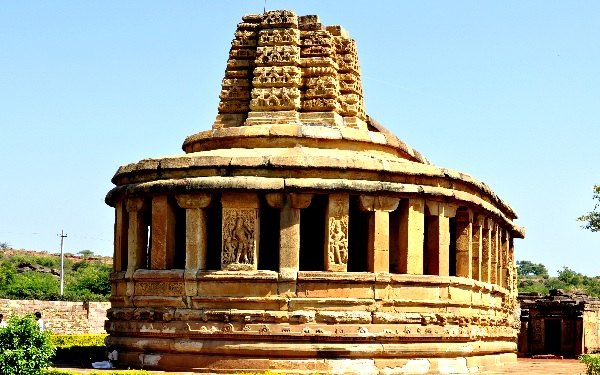
Lad Khan Temple
The Lad Khan temple has two matapas which looks like Shiva Linga. These mantapas are Mukhamantapa and Sabhamantapa. The mukhmantapa rests on twelve pillars while the pillars on which the sabhamantapa rests are arranged in two concentric squares.
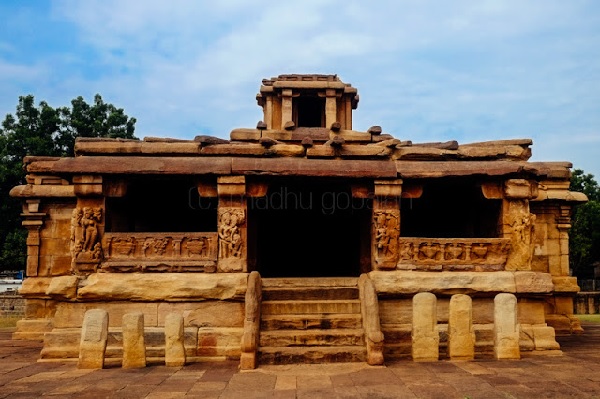
The temple has lattice style windows and carved walls with floral designs. The temple was named so because a general named Lad Khan lived here.
Ravana Phadi Cave
Ravana Phadi Cave temple was built in sixth century. It has a rectangular shrine with two mantapas. There is an inner room where a Shiva Linga is established. There are large figures of Lord Shiva on the walls which also include dancing Shiva.
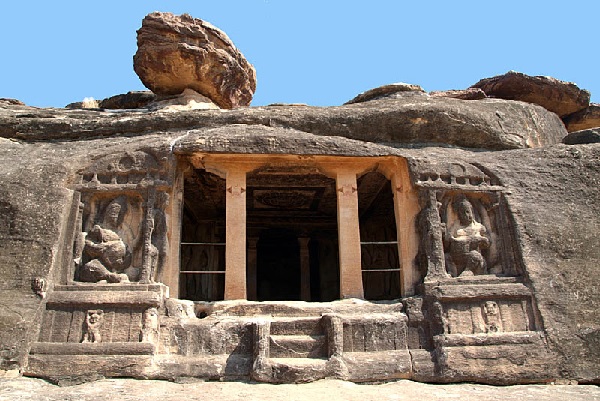
Huchappayya Temple
Huchappayya temple is a Shiva temple built nearby Malaprabha river. The temple has mukhamantapa, a hall, and sanctum. The porch and hall have pillars having carved images of gods with their spouse. The image of Nataraja can be seen on the roof of the temple.
Group of Yeniar Shrines
The group of Yeniar shrines consists of eight temples which were built in 12thcentury. Each temple has a porch along with a cella and a hall. The temples were constructed on the banks of Malaprabha river.
Ramlinga Group of Temples
The main temple in this group is Ramlinga which is a trikutachala shrine. Out of these three, two have Shiva Linga and the third has the image of Goddess Parvati. This shrine was built in 11th century AD. Along with these there are two towers called Kadambanagara towers which was a temple form of architecture founded in 4th century by Mayurasharma, founder of Kadamba dynasty.
Galaganatha Group of Temples
Galaganatha Group of Temples were built on the banks of Malaprabha river in which the main Shrine is Galaganatha which has the statue of Lord Shiva. The images of Ganga and Yamuna can be found at the entrance. Total number of temples in this group is 38 and besides Galaganatha, most of them are ruined.
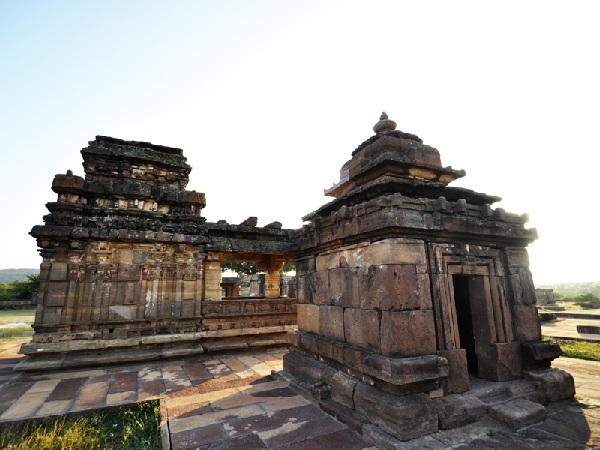
Suryanarayana Temple
The temple has three statues which includes Surya and his wives Usha and Sandhya. All the statues are being drawn by horses. The height of Surya’s statue is 0.6m. There is a four pillared sanctum along with a tower of Nagara style.
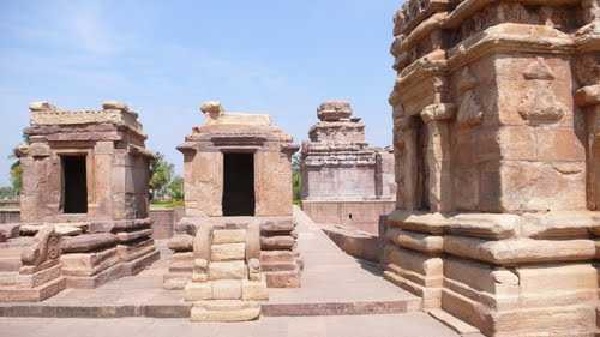
Chakra Gudi and Badigera Gudi
Chakra Gudi consists of a hall and a sanctum. Along with these, there is a tower which was built on the basis of rekhanagara style. The temple is supposed to be built in 9th century. Badigera Gudi has a porch, hall, cell and a tower. The tower was built in Rekhanagara style. Previously this temple was a Sun temple. This temple was also built in 9th century.
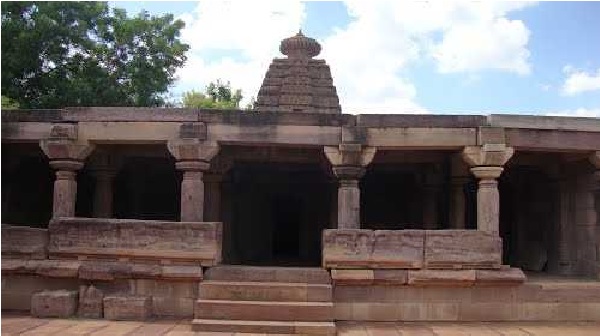
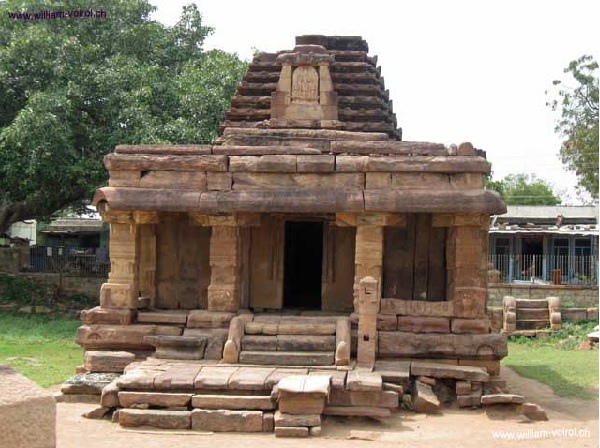
Ambigera Gudi Group and Chikkigudi Group
There are three temples in the Ambigera group of temples. The rekhanagara style tower can be found on the biggest one. The temple is supposed to be built in 10th century. In the Chikkigudi group of temples, Chikkigudi is the largest one having a hall, a cell, and a mantapa. It is supposed to be built in 7th century.

Huchimalli Gudi Temple
Huchimalli Gudi has ardhamantapa which is connected to the main shrine. The sanctum of the temple is prasakshinapath and has a tower in rekhanagara style. A new thing introduced in the temple was Shukanasa or vestibule.
Gaudara Gudi
Gaudara Gudi was built on the same architecture as the Lad Khan Temple. There are sixteen pillars on the outer wall and the base of the temple is moulded. There is an inscription in the temple which is supposed to be of 8thcentury which tells that the temple was known as Bhagwati temple.
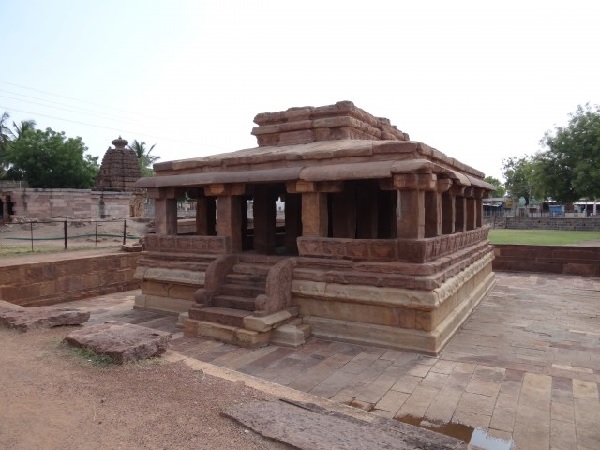
Rachi Gudi
Rachi Gudi was constructed in 11th century. It has a trikutachala each having Lord Shiva’s image. The temple stands on a high platform and the cells face three different sides. The external walls of the temple has the images of Ganapati, Nataraja, and Vishnu.
Huchappayya Matha and Halabasappana Gudi
Huchappayya Matha is a temple having a sanctum and a hall. The ceiling has trimurti figure and there is an inscription of 1067AD. Halabasappana Gudi is a small temple which has a hall and a sanctum.
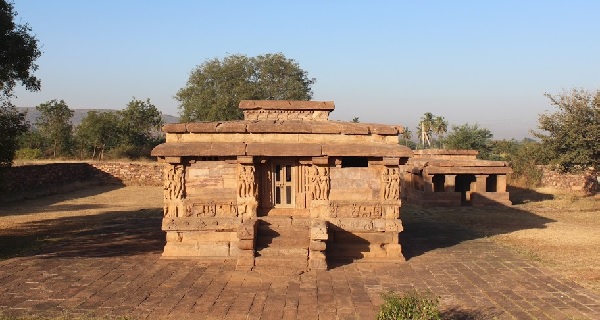
The idols of Ganga and Yamuna can be found at the entrance. The size of the temple is not very big.
Kontigudi group of temples
Kontigudi Group of Temples include four temples which were constructed in 7thcentury. The first temple in this group has trimurty idols on the ceiling of the mantapa. Later many other things were added to the temple. One of the four temples constructed in 10th century has been ruined.
Aihole - Jain Temples
There are Jain temples in Aihole as some of the Chalukya rulers were the followers of Jainism. Some of these temples are as follows −
Meguti Jain Temple
Meguti Jain temple has never been completed since the starting of its construction. Ravikriti, a courtier of Pulakeshin II, has constructed this temple between 634 and 635AD. The temple is dedicated to the 24th Tirthankara of Jains whose name was Mahavira. Sandstone is used to construct the temple and it is considered as the oldest temple. The temple is constructed on a raised platform and devotees can reach the temple through a staircase which further leads to the mukhamantapa.

There is one more shrine on the roof that is above the main shrine in the hall. There is an entrance from portico that leads to a chamber which is divided by a wall. While going up, devotees will reach the second chamber that leads to a large hall and in its center a sanctum is there. An image of Jina can be found at the back of the sanctum. Another thing in the temple is the circumambulatory path which connects the chambers.
Charanthimatha Group of Temples
Charanthimatha group of temples has three shrines with a portico so it is known as trikutachala. The temple is based on Kalyana Chalukya architecture and was built between 11th and 12th centuries. Two basadi with one porch are also there and each basadi has the statues of 12 tirthankaras.
Jain Cave Temple
If devotees or visitors come from the direction of Badami or Pattadakal, then they can see Jain cave temples at the entrance. The temple is built on the banks of Malaprabha river. Inscriptions in Kannada can be found near the cave.
Aihole - How to Reach?
Aihole has only road network so it is easy to reach here by road. Aihole does not have airport or railway station. The nearby railway station is Bagalkot and Goa is the nearest airport. Bagalkot is 34km away and Goa is 230km away from Aihole.
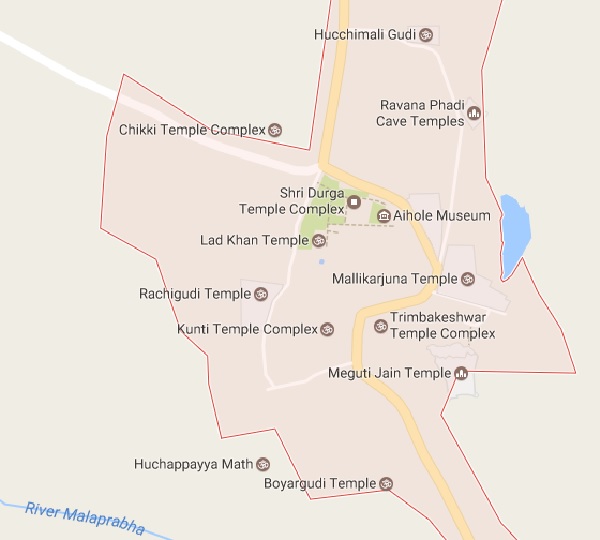
Some of the nearby cities to Bagalkot is as follows −
- Bagalkot to Bangalore
- By rail – 615km
- By road – 534km
- Bagalkot to Mysore
- By rail – 741km
- By road – 597km
- Bagalkot to Chennai
- By rail – 980km to 1223km (depends on the route as there is no direct train)
- By road – 828km
- Bagalkot to Hyderabad
- By rail – 465km
- By road – 417km
- Bagalkot to Hubbali
- By rail – 151km
- By road – 131km
- Bagalkot to Bijapur
- By rail – 97km
- By road – 86km
- Bagalkot to Solapur
- By rail – 163kms
- By road – 185km
By Air
Aihole does not have its airport but the nearest airport is Goa which is 230km away from Aihole. Goa airport or Dabolim airport is an international airport that connects Goa from cities in India and abroad. The airport is 30km away from Panjim, capital of Goa.
By Train
Aihole does not have railway network but the nearest railway station is Bagalkot which is 34km away from Aihole. Bagalkot is well-connected with many cities though very few trains have stoppage here.
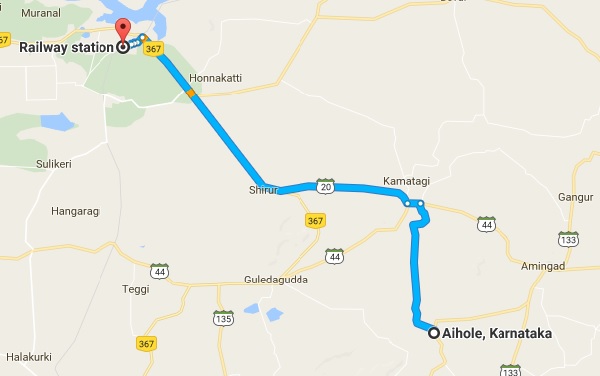
No rajdhani, shatabdi, garib rath and other premium trains run from here. Even superfast trains also do not run on this route but fast express trains and passenger trains have stoppage here.
By Road
Aihole does not have bus station but buses come to nearby cities like Badami, Hubbali, Bagalkot etc. Tourists can catch taxi from there to reach Aihole. Pattadakal is connected with Aihole through National Highway No. 14.
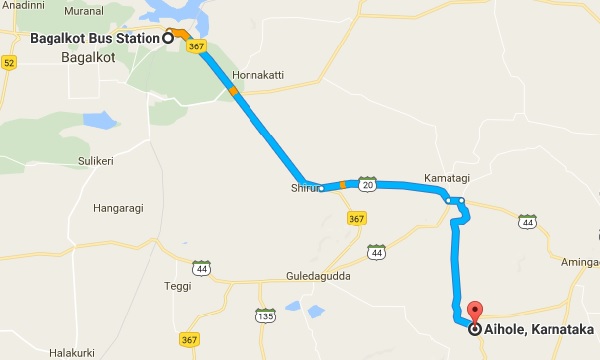
Local Transport
Aihole is a very small place and tourists can visit the whole village by foot. There are local bus services that can be found in the inner part of the village.
Aihole - Nearby Places
Aihole is a very small town but has huge number of temples which counts to around 125. Besides visiting all these temples, tourists can also visit nearby places like Pattadakal, Badami, and Hampi. All these places have temples as well as other monuments.
Pattadakal
Pattadakal is around 14km away from Aihole. It is a village where people can see Chalukya monuments. Since the place was considered as holy, the coronation ceremony of the Chalukya kings were held here. The first ruler to be coroneted here was Vijayaditya. Chalukyas made the place their capital and built many temples here.

The list of some of them include
- Jain Narayana Temple
- Virupaksha Temple
- Sangameshwara Temple
- Chandrashekhara Temple
- Mallikarjuna Temple
- Kashi Vishwanath Temple
The architectural styles used in the construction of temples were Rekha, Nagara, Prasada, and Dravida Vimana.
Badami
Badami was the regal capital of Chalukyas which was previously known as Vatapi. The place has many temples built during the rule of Chalukya kings. Pulakeshin I founded the city in 540AD. Kirtivarman I and Mangalesha were the sons of Pulakeshin I who built many temples.

Kirtivarman I succeeded his father and after him his brother Mangalesha succeeded. Vatapi was later destroyed by Pallavan rulers. The monuments to be visited in Badami are Cave temples and Badami Fort.
Hampi
Hampi is one of the largest cities of India which is located in the state of Karnataka. It is located at a distance of around 139km from Aihole. There are many temples and other monuments which the tourists can visit.

Ashokan inscription tell that previously Hampi was a part of Mauryan empire. Later Hampi became the capital of Vijayanagara empire from 1343 to 1565. In 1565, it came under the rule of Deccan Muslims. Some of the temples of Hampi are
- Malyavanta Raghnath Swamy temple
- Hazara Rama Temple Complex
- Krishna Temple
- Vittala Temple
- Viouraksha Temple

Comments
Post a Comment